Like an artist’s blank canvas, your apartment holds endless potential for creating a lush indoor sanctuary. You’ll discover how to transform limited urban space into a thriving garden oasis through seven proven strategies that balance aesthetics with functionality. From vertical gardens that maximize wall real estate to low-maintenance succulents that thrive in challenging conditions, these plant solutions will help you cultivate greenery without sacrificing precious square footage. Let’s explore how to bring nature’s beauty indoors while working within your space constraints.
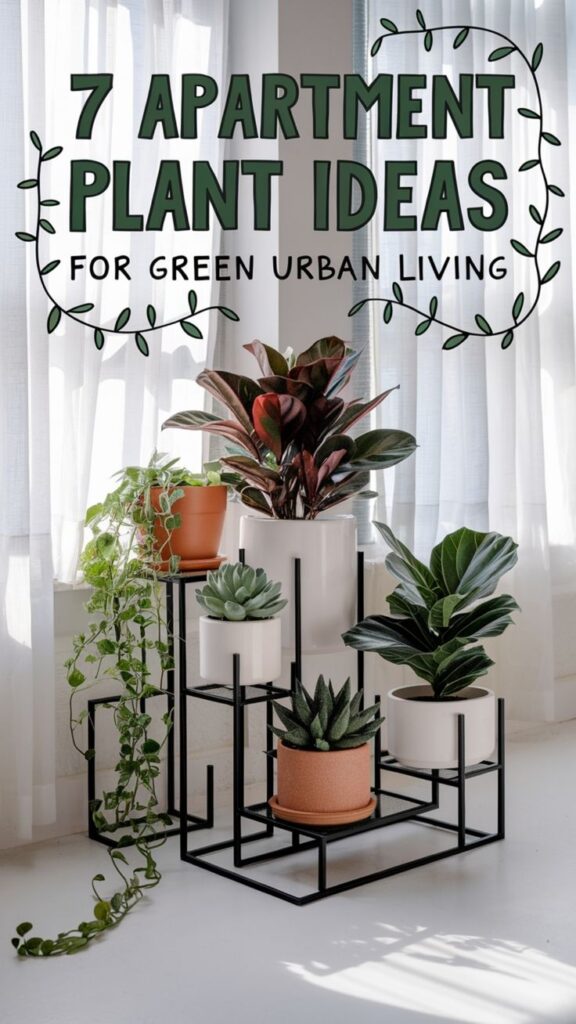
Contents
Space-Saving Vertical Garden Solutions
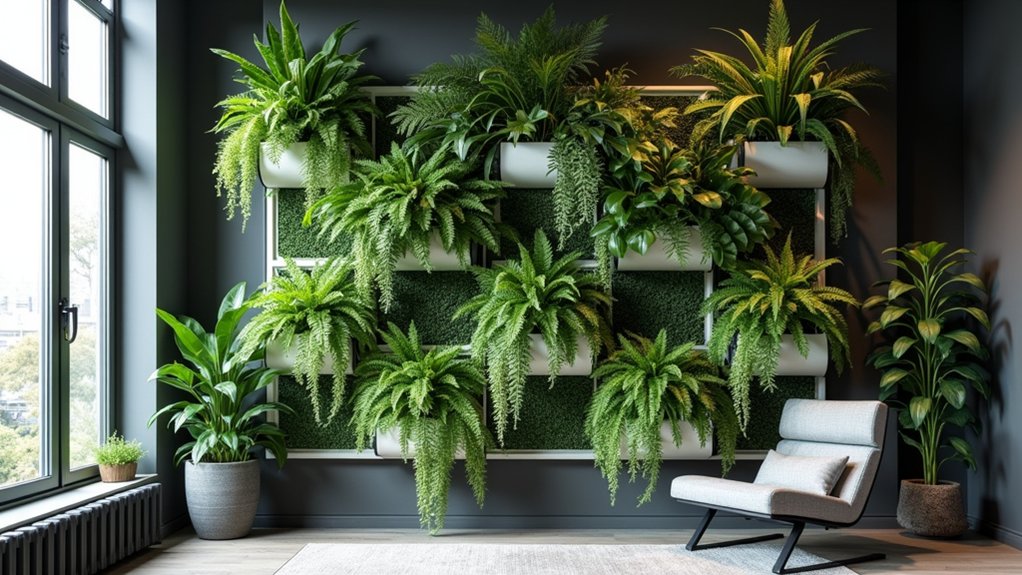
Vertical gardens maximize limited apartment space by transforming walls and corners into lush, living tapestries of greenery. These space-efficient systems can range from pocket planters and modular wall panels to hanging containers and tiered stands, allowing urban gardeners to grow various plants upward rather than outward.
The visual impact creates an eye-catching focal point while efficiently utilizing vertical space that would otherwise remain bare.
- Light: Most vertical gardens need moderate to bright indirect light, with 4-6 hours of daily sunlight; position according to specific plant requirements
- Water: Install proper drainage systems; water 2-3 times weekly depending on plant selection and season
- Soil: Use lightweight, well-draining potting mix enriched with organic matter
- Temperature: Maintain consistent indoor temperatures between 65-80°F (18-27°C)
- Humidity: Keep humidity levels between 40-60% for optimal growth
- Air Circulation: Ensure adequate airflow to prevent mold and fungal issues
Regular maintenance ensures vertical garden success through systematic care routines. Inspect the support structure monthly for stability and signs of wear, trim dead foliage promptly to prevent disease spread, and rotate plants periodically to ensure even growth.
Monitor irrigation systems weekly for clogs or leaks, and fertilize with balanced, water-soluble nutrients during the growing season. Periodically clean plant leaves to remove dust and check for pest infestations, addressing any issues immediately to maintain the garden’s health and appearance.
Low-Light Indoor Plants for Dark Corners
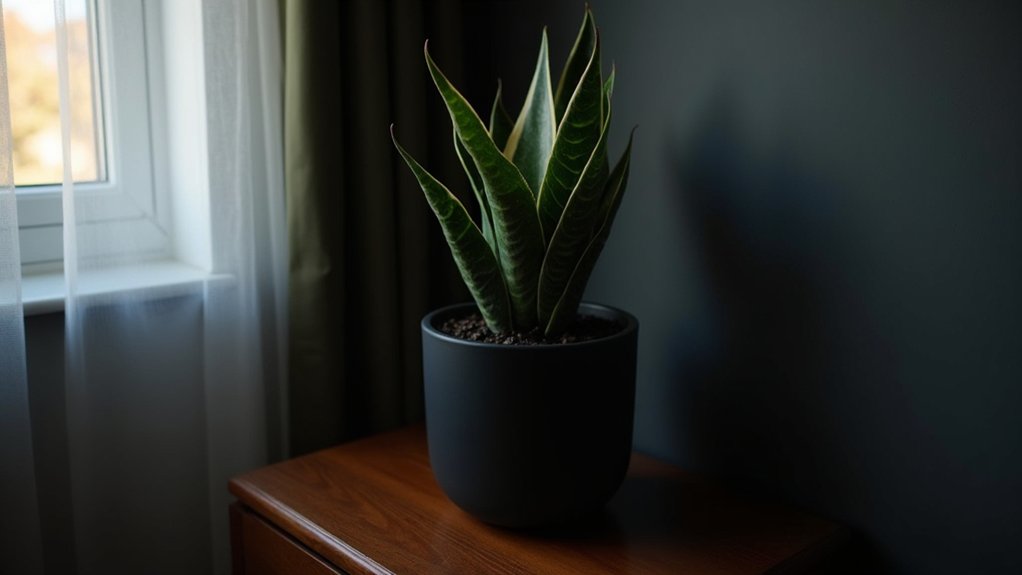
Low-light indoor plants are specially adapted species that can thrive in darker areas of apartments where natural sunlight is limited.
These plants typically feature broader, darker leaves that efficiently capture and process minimal light. Common varieties include snake plants, ZZ plants, pothos, and peace lilies, which have evolved to flourish in the understory of dense forests, making them perfect candidates for shadowy apartment corners.
- Light: Tolerates low to moderate indirect light; avoid direct sunlight
- Water: Allow top 1-2 inches of soil to dry between waterings
- Soil: Well-draining potting mix with good aeration
- Humidity: Adaptable to normal indoor humidity levels
- Temperature: Comfortable in average room temperatures (60-75°F)
- Fertilizer: Light feeding every 2-3 months during growing season
Regular maintenance for low-light plants focuses on preventing common issues that arise in darker conditions.
Rotate plants quarterly to ensure even growth, dust leaves monthly to maximize light absorption, and trim yellowing or dead foliage promptly to prevent fungal problems that can develop in lower-light conditions.
Watch for signs of overwatering, which is more common in low-light situations since reduced light means slower water uptake by the plant.
Compact Herb Gardens for Kitchen Window Sills
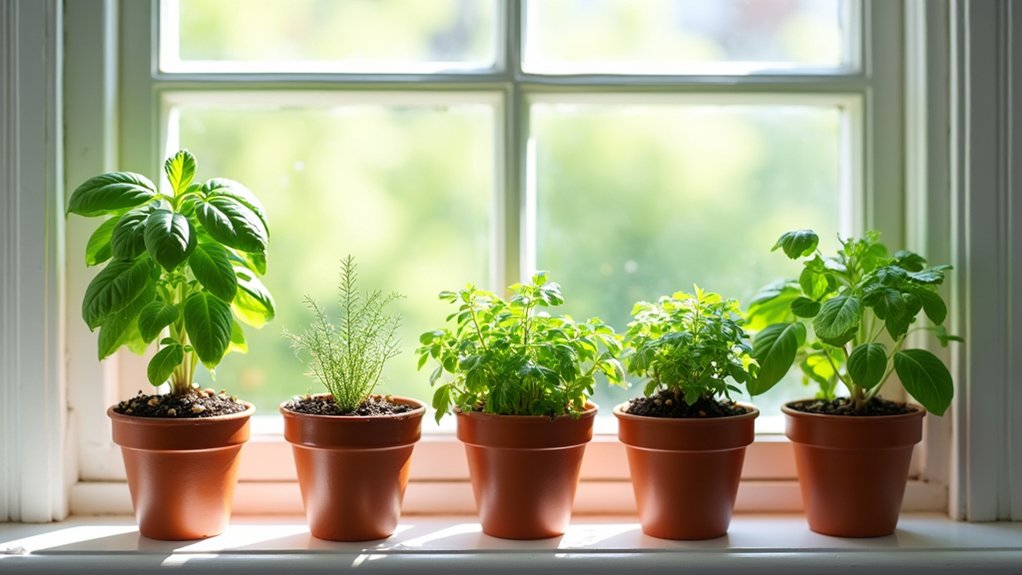
Kitchen window sill herb gardens maximize limited apartment space while providing fresh culinary ingredients within arm’s reach. These compact gardens typically feature small containers arranged in a row, housing popular cooking herbs like basil, thyme, parsley, and mint.
The setup can range from matching terra cotta pots to modern self-watering containers, often incorporating space-saving vertical elements or tiered displays to accommodate multiple plants while maintaining a tidy appearance.
- Light: 4-6 hours of direct sunlight daily, south or west-facing windows preferred
- Water: Consistent moisture, water when top inch of soil feels dry
- Soil: Well-draining potting mix specifically formulated for herbs
- Temperature: 65-70°F (18-21°C), away from cold drafts
- Container: 6-8 inch pots with drainage holes
- Spacing: 2-3 inches between plants for proper air circulation
Regular pruning and harvesting are essential for maintaining healthy window sill herbs. Trim stems just above a leaf node to encourage bushier growth, and remove any yellowing or dead foliage promptly.
Rotate containers quarterly to ensure even growth, and fertilize with a balanced, water-soluble fertilizer every 4-6 weeks during the growing season. Combat potential pest issues by inspecting leaves weekly and maintaining good air circulation between plants.
Air-Purifying Plants for Better Breathing
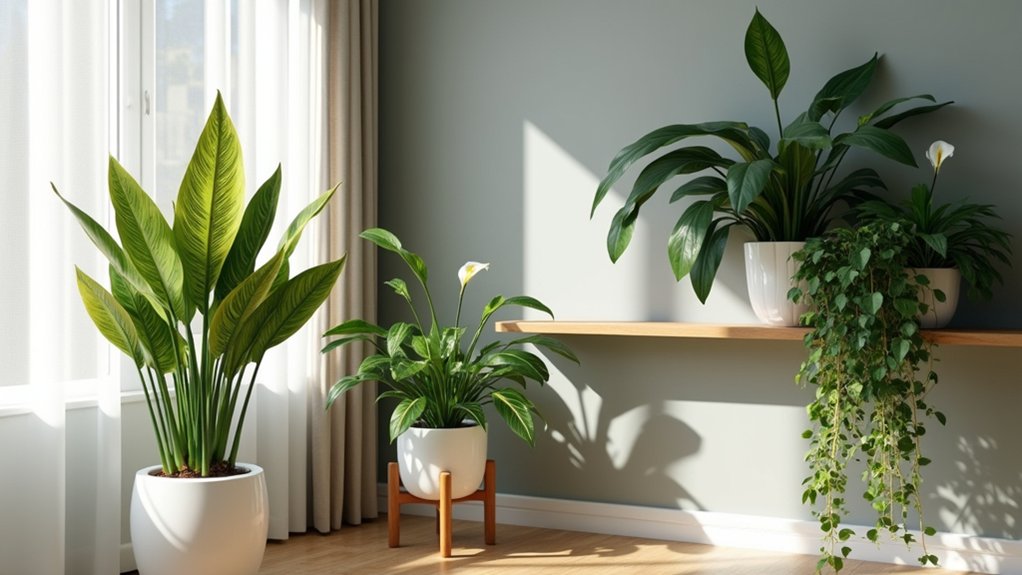
Air-purifying plants are natural filtration systems that help remove common indoor pollutants, including formaldehyde, benzene, and carbon monoxide from the air. Popular varieties include the snake plant (Sansevieria), spider plant (Chlorophytum comosum), peace lily (Spathiphyllum), and devil’s ivy (Epipremnum aureum).
These plants typically feature broad leaves or long, architectural fronds that maximize their air-cleaning capabilities while adding aesthetic value to indoor spaces.
- Light: Most air-purifying plants thrive in moderate to bright indirect light, though some varieties like the snake plant can tolerate low light conditions.
- Water: Water needs vary by species, but generally require watering when the top 1-2 inches of soil feels dry.
- Soil: Well-draining potting mix with good aeration.
- Temperature: Comfortable room temperature between 60-75°F (15-24°C).
- Humidity: Average indoor humidity levels of 40-60%.
- Container: Pots with drainage holes to prevent root rot.
Regular maintenance of air-purifying plants involves dusting their leaves monthly to maintain optimal air-filtering efficiency.
Trim yellowing or dead leaves promptly to prevent disease spread and encourage new growth. Rotate the plants quarterly to ensure even growth and check periodically for pests, particularly spider mites and mealybugs, which can hamper the plant’s air-cleaning abilities.
Most air-purifying plants benefit from monthly fertilization during the growing season using a balanced, water-soluble fertilizer.
Hanging Plants to Maximize Floor Space
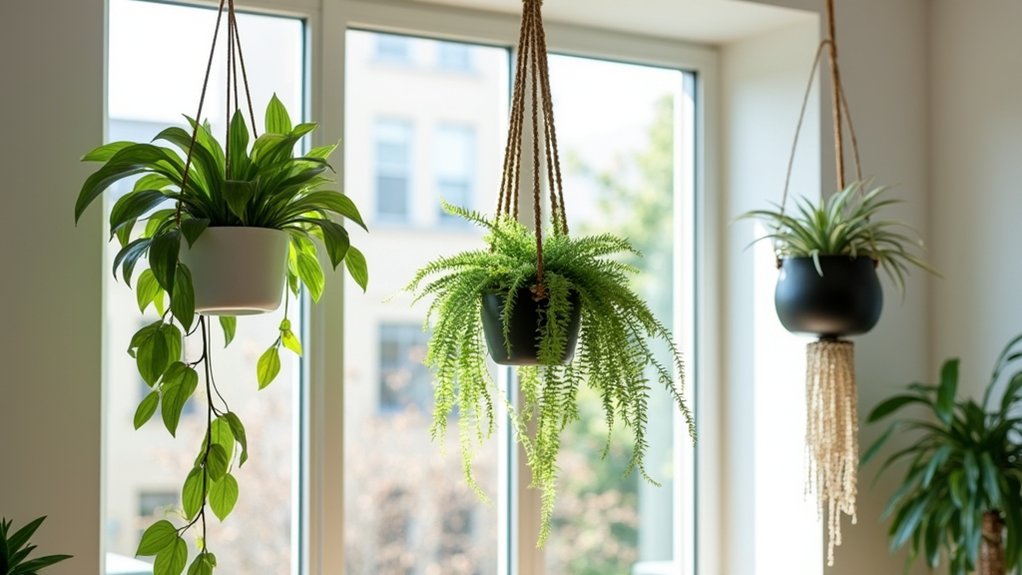
Hanging plants offer an ingenious solution for urban dwellers seeking to add greenery without sacrificing precious floor space. These suspended gardens create visual interest at different heights while drawing the eye upward, making rooms appear larger and more dynamic. Popular options include trailing pothos, spider plants, string of pearls, and Boston ferns, which cascade gracefully from mounted planters, macramé holders, or ceiling hooks.
- Light: Most hanging plants prefer bright, indirect sunlight; avoid harsh afternoon sun
- Water: Allow top inch of soil to dry between waterings; mist regularly for humidity
- Soil: Well-draining potting mix with added perlite or orchid bark
- Temperature: 65-80°F (18-27°C)
- Container: Lightweight pots with drainage holes and saucers to catch excess water
- Support: Secure mounting hardware rated for plant and pot weight when wet
Regular grooming is essential to maintain hanging plants’ attractive appearance and prevent them from becoming unruly. Trim yellowed or dead foliage promptly, rotate containers weekly for even growth, and inspect regularly for pests, especially under leaves where insects often hide.
Fertilize monthly during growing season with balanced, water-soluble fertilizer at half strength, and repot every 2-3 years or when roots become visible through drainage holes.
Drought-Resistant Succulents and Cacti
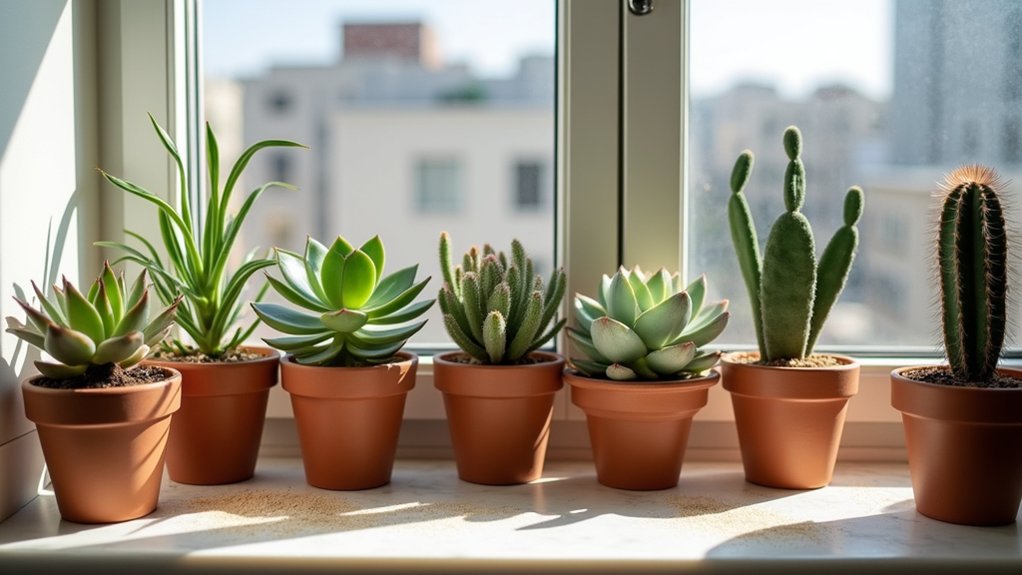
Drought-resistant succulents and cacti are exceptional choices for apartment living, featuring thick, fleshy leaves or stems that store water, allowing them to thrive with minimal care.
These plants come in a vast array of shapes, sizes, and colors, from the compact rosettes of echeveria to the tall, sculptural forms of barrel cacti. Their unique adaptations, including waxy coatings and modified leaves, help them retain moisture and survive in arid conditions, making them perfect for busy apartment dwellers or those prone to forgetting regular watering schedules.
- Light: Bright, direct sunlight for most varieties; minimum 6 hours daily
- Water: Allow soil to dry completely between waterings; reduce watering in winter
- Soil: Well-draining cactus mix or regular potting soil mixed with sand and perlite
- Temperature: 60-80°F (15-27°C); can tolerate higher temperatures
- Humidity: Low to moderate; tolerant of dry air
- Container: Pots with drainage holes; terracotta preferred for moisture control
To maintain healthy succulents and cacti, rotate pots quarterly to ensure even growth, and inspect regularly for signs of pests like mealybugs or spider mites.
Remove any dead leaves promptly to prevent rot, and dust leaves gently with a soft brush to keep their pores clear for proper photosynthesis.
During the growing season (spring and summer), provide a diluted cactus fertilizer every 4-6 weeks, but cease fertilization during dormant winter months to prevent unwanted growth that could weaken the plant.
Small-Scale Statement Plants With Big Impact

Small-scale statement plants offer dramatic visual impact while maintaining a compact footprint perfect for apartment living. These eye-catching specimens include varieties like the snake plant with its bold, upright leaves, the sculptural ZZ plant with its glossy foliage, and the Chinese evergreen’s striking variegated patterns.
Despite their modest size, these plants command attention through unique shapes, distinctive coloring, or architectural growth patterns, making them ideal focal points for small spaces.
- Light: Most tolerate low to moderate indirect light; some varieties can handle bright indirect light
- Water: Generally drought-tolerant; water when top 1-2 inches of soil feels dry
- Soil: Well-draining potting mix with added perlite
- Temperature: Comfortable in normal room temperatures (65-80°F)
- Humidity: Adaptable to average indoor humidity levels
- Container: Choose pots with drainage holes that are 1-2 inches larger than root ball
Regular grooming keeps small statement plants looking their best while preventing potential issues. Remove any yellowed or damaged leaves promptly, rotate the pot quarterly to ensure even growth, and dust foliage monthly with a damp cloth to maintain their striking appearance.
Avoid overcrowding these specimens with other plants, as they perform best when given space to display their distinctive characteristics, and consider elevating them on stands or shelves to maximize their visual impact.
